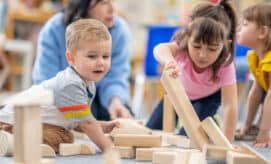In response to new guidelines and regulations related to COVID-19, many early learning educators and caregivers are making big changes to their programs, including restructuring classrooms, shifting curriculum, and re-organizing daily schedules in order to prevent the spread of germs. For children, that means spending the majority of their days broken up into smaller groups.
Small groups might be new to your practice as an educator or caregiver, but working with children in more individualized settings has many benefits, and is a great practice during the pandemic and beyond. The pandemic has been incredibly stressful, but it has also been a time of learning and creativity, in which we can try new things and try to rebuild our early learning programs so that they are even stronger than they were before.
Small Groups in ECE Practice
Small groups means just that– typically no more than five children participating together in an activity or project with the support or supervision of a teacher.
Smaller groups have a number of benefits, including more opportunities for interaction with and among the children. In addition, smaller groups offer greater flexibility. With fewer children to supervise, teachers can set up art projects and other activities that can be enjoyed by all the children while the teachers work with each individual child on kindergarten readiness skills, including STEM projects or writing and early literacy activities.
How to Organize Groups
In her paper, When Few is More: Small Groups in Early Childhood Classrooms, Barbara Wasik shares that small groups should be “intentionally organized,” meaning that each child is deliberately chosen for a particular group or activity. For example, a few children who are having trouble with a specific letter might be put into a group together so that they have an opportunity to practice their skills together. Or, two children who do not typically get along well might be placed in a group together to read books about friendship-building, empathy, or conflict resolution.
Wasik’s article describes research findings that support the value of having varying skill levels in a small group to promote learning, as children support one another. “The children who know the names of many letters, for example, can provide a model for children who are learning them…Similarly, the children who are learning the letter names are providing opportunities for the other children to expand their vocabulary by explaining, for instance, the difference in the shapes of the letters. Everyone in the group benefits from each other’s knowledge and skill.”
Small Groups Enhance Learning
One of the greatest benefits of small groups is the deeper learning made possible when teachers are able to better meet the needs of each child through individualized support. Children benefit from these experiences in the following ways…
-
Language development: In small groups, children have more frequent opportunities to engage in activities leading to language development, including self-expression, feedback from teachers, and back-and-forth communication. Teachers can also be more actively engaged by expanding on the children’s statements with questions and feedback that will deepen the conversation, and inviting them to share stories they’ve heard outside of the classroom.
-
Cooperation: Smaller groups encourage children to practice working alongside their peers on activities. As they work together towards a common goal, children communicate, problem solve, compromise, and share, all of which contribute to healthy social-emotional development.
-
Better engagement: When children spend time in small groups, they have the benefit of being able to connect with their peers, their teacher, and the activity that they are working on. The teacher can provide instruction that meets the children’s needs, follows their unique interests, and connects with the children individually. Teachers are less overwhelmed by large class sizes and are able to be more present with the children they are with.
Activity Ideas for Small Groups
Small group time does not have to require a lot of setup. It can be as simple as reading and discussing a story, going for a nature walk in your yard, dancing with music, playing a game, or singing songs together.
If you are looking for a more focused project, you might enjoy some of the activities below. Each activity works for a variety of ages and skill levels, is easy to set up, and helps children to build important kindergarten readiness skills.
-
Giant Letter Dots: early literacy hands-on letter activity with dot markers that requires only a big piece of butcher paper, a Sharpie, and dot markers. (For social distancing, you’ll want to set this activity up on individual pieces of paper, rather than one big sheet.)
-
Easy Prep Number Sense Activities: a few simple, easy-to-set-up activities that children can work on in small groups to practice number sense, counting, and basic addition and subtraction
-
STEM activity: How to Compare Weights with a Balance Scale: a simple math activity for introducing weight. Educators can walk children through the scientific method as they learn.
More Resources





